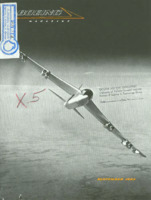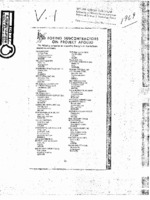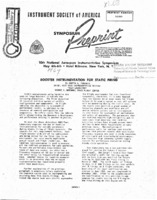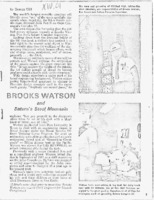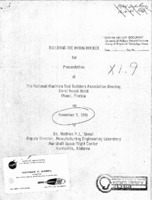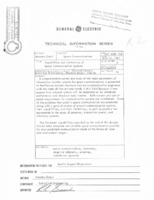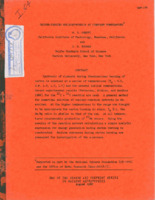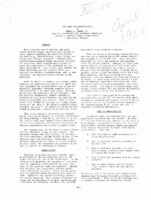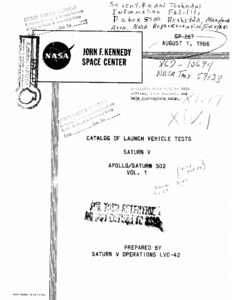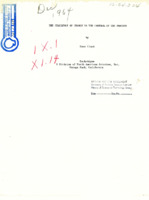
Browse Items (1976 total)
Sort by:
-
Boeing Magazine, vol. XXXIV, no. 9, September 1964.
The magazine includes the articles "Next Stop: Mars", "Up the river to the Moon", "Air Force Tests New Missile", "Shake Well Before Using", "Quick Cargo Cash", "New Heart for the B-52", "What-Next Man", "Mostly on Time", and "Faster Inspector". Also included is a briefing of events in the Boeing Company. -
Boeing Subcontractors on Project Apollo.
The document is a list of Boeing subcontractors on Project Apollo including contractor locations, projects, and funding. -
Booster instrumentation for static firing.
The document is an Instrument Society of America Symposium Preprint of the "Booster Instrumentation for Static Firing" by Marin A. Ferrario. "Booster Instrumentation for Static Firing" was included in the 10th National Aerospace Instrumentation Symposium which occured from May 4th - 6th at the Hotel Biltmore in New York, NY. -
"Brooks Watson and Saturn's Steel Mountain."
Included are a copy of page 7 of the December 1963 publication of Pan Am (GMRD) Clipper magazine and a letter from Pan American World Airways to David Christensen. The magazine article briefly describes the gantry that surrounded Saturn-V and Pan American's Saturn complex Supervisor, Brooks Watson. -
Draft of "Building the Moon Rocket."
"Building the Moon Rocket" was presented at the National Machine Tool Builders Association Meeting, Doral Beach Hotel, Miami, Florida on November 3, 1965 by Dr. Mathias P.L. Siebel, the Deputy Director, Manufacturing Engineering Laboratory. There are handwritten notes throughout. -
"Capabilities and Limitations of Space Communication Systems."
The paper "Capabilities and Limitations of Space Communication Systems" is part of a General Electric Technical Information Series prepared for the Apollo Support Department. The abstract states "A survey and study of the basic parameters of information transfer systems for space communications is presented in this paper, to familiarize systems checkout and on communication engineers with the state-of-the-art and trends in this field. Both current and anticipated requirements for space communication systems are briefly considered. Some of the problems that exist in space communication are presented, along with a general review of current communication systems, their capabilities, and limitations as well as possible improvements in the areas of spacecraft directional antennas, ground stations and antennas, spacecraft transmitter power, and telemetry systems. It is concluded that the increased capabilities expected by the end of this decade should make adequate and reliable space communication possible for most predicted communication needs of future space missions at lunar and near-planet ranges." -
"Carbon-Burning Nucleosynthesis at Constant Temperature."
"Carbon-Burning Nucleosyntesis at Constant Temperature" is part of the Orange Aid preprint Series in Nuclear Astrophysics, August 1968. The abstract states "Syntesis of elements during thermonuclear burning of carbon is examined at a series of temperatures (T=0.6, 0.8, 1.0, 1.2, 1.4) and for several initial compositions. Recent eperimental results (Ptterson, Winkler, and Zaidins 1968) for the 12C+!@C reaction are used. A general method for numerical solution of nuclear-reaction networkds is described. At the higher temperatures in the range now thought to be appropriate for carbon burning in stars, -
"The Case for Compatibility."
"The Case for Compatibility" is a paper by Robert L. Smith, Jr., who worked in Quality and Reliability Assurance Laboratory at George C. Marshall Space Flight Center. The summary states, "Ever since the use of missiles and space launch vehicles began, questions have existed in every program regarding the similarity between upstream (e.g., manufacturing, static firing ) and launch site checkout equipment. Programs have existed which utilized nearly identical equipment for both uses; other programs have existed in which any resemblance of the equipment was probably coincidental. Many factors have entered the final decisions, not the least of which were economic and schedule considerations, and, in some instances, the organizational structure of the developer." -
Catalog of launch vehicle tests Saturn V : Apollo/Saturn 502 : Volume 1, Section 1.
The document is Volume 1, Section 1 of a list of Saturn V launch tests including but not limited to test titles, test numbers, test objectives, and test descriptions related to AS-502. -
"The Challenge of Change vs the Control of the Process."
The introduction states, "This paper is designed to present the Rocketdyne engine program as it applies to the Saturn launch vehicles and will apply to the Apollo program of manned flight to the moon (Fig. 1). The vehicle that will launch this flight is the Saturn V, the largest and most powerful of the Saturn family. This vehicle, 362 feet tall and 33 feet in diameter, will be capable of sending a 45-ton payload to the moon or placing a 120-ton payload in earth orbit. Five F-1 engines power the first stage of the Saturn V; five J-2 engines, the second stage; and one J-2 engine, the third stage. The thrust of the first-stage engines alone will be equivalent to 160 million horsepower. Both of these engines, the F-1 and the J-2, were designed at, and are currently being produced by Rocketdyne."
